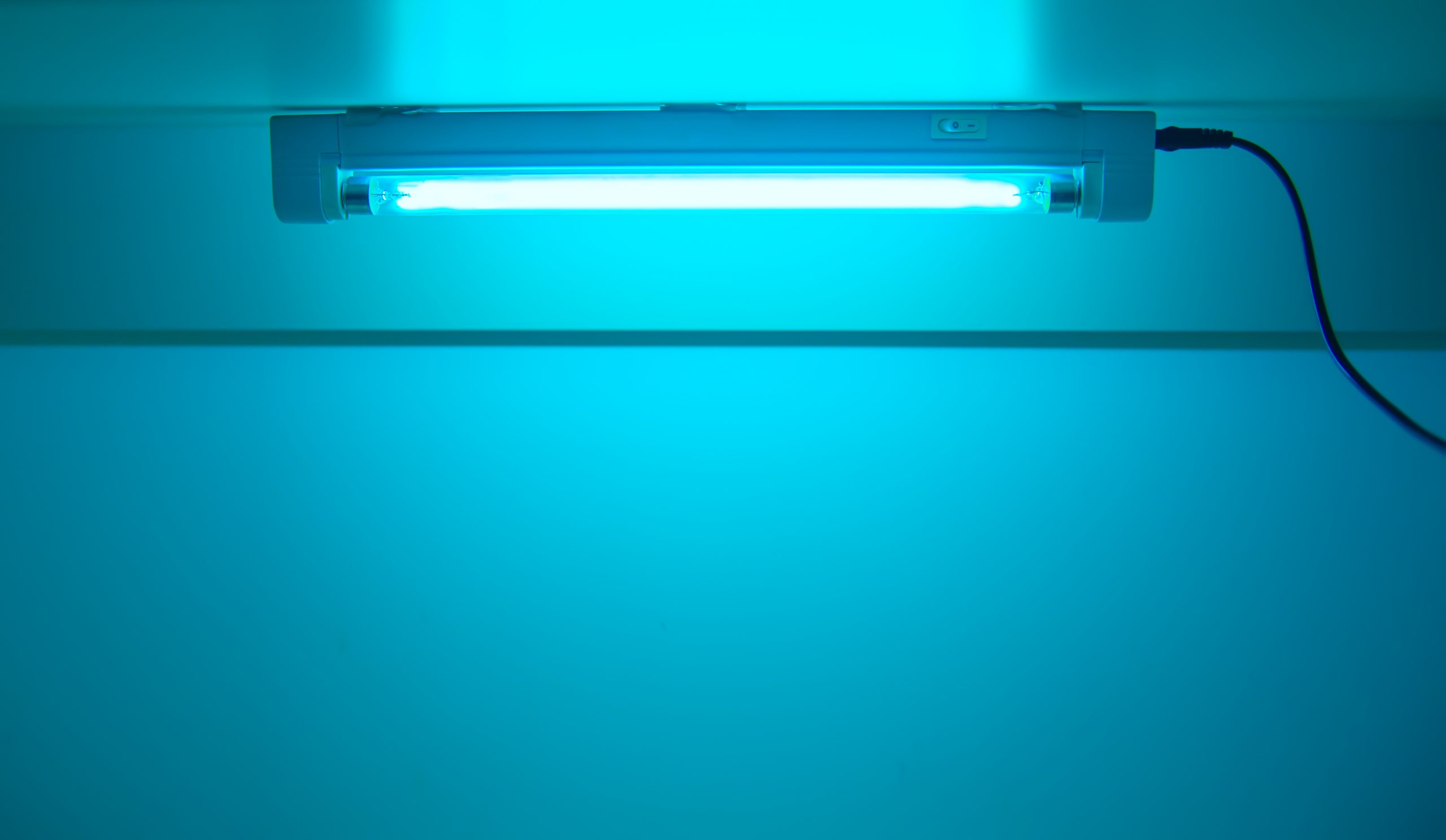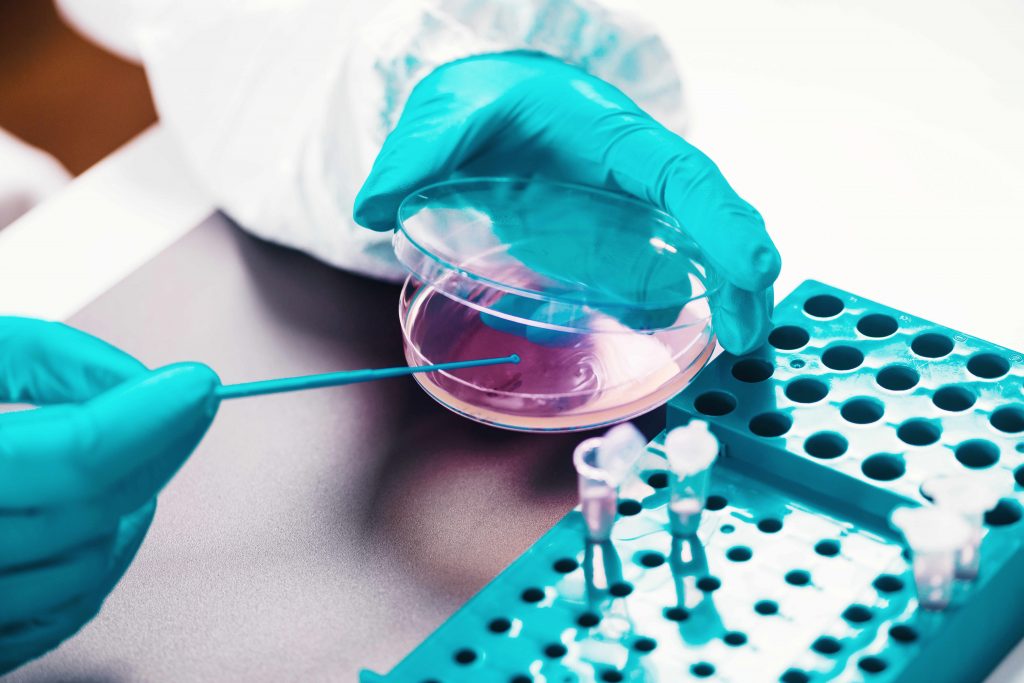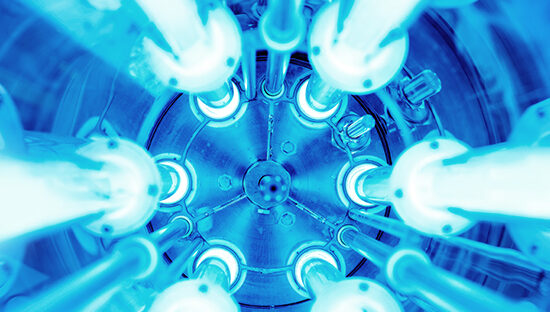
What is UV irradiation?
UV irradiation has been a validated technology for the decontamination of surfaces, as well as air and water, for several decades. UV light covers a wavelength spectrum from 100 to 380 nm and is subdivided into three regions by wavelength: UV-A (320 to 400 nm), UV-B (280 to 320 nm), and UV-C (200 to 280 nm). Among these wavelength ranges, UV-C has been shown to possess the highest efficacy in terms of microbial inactivation. This is due to the fact that the wavelength of 250–270nm, is strongly and mainly absorbed by the nucleic acids of microbial cells leading to the inactivation of microorganisms.
This is because the intercellular components of microbes (e.g., RNA, DNA, and proteins) can sensitively absorb UV-C photons. Absorbed UV-C photons cause critical damage to the genomic system of microorganisms (nucleic acid and microorganismal proteins), preventing them from replicating and surviving, where the adenine–thymine bond is collapsed and a covalent linkage, pyrimidine dimer, is generated between two adenines leading to inability of the cell to replicate.
Therefore, the effect of UV irradiation on microorganisms is called “inactivation” and not “killing”.
What are the most commonly used UV-C light sources?
Numerous trials and studies have shown the significance of UV-C germicidal lamps in reducing the number of viable pathogenic microorganisms including methicillin-resistant Staphylococcus aureus, Vancomycin Resistant Enterococci, Clostridium difficile, Influenza viruses, Coronaviruses, and many others.
Different UV-C light sources have been utilised for different industrial and healthcare settings, such as the conventional low and medium pressure mercury UV lamps (254 nm), UV light-emitting diodes (UV-LEDs) 200-280 nm, pulsed xenon lamps (200-390 nm) and far-UVC (200–240 nm) radiating excimer and micro plasma lamps.
Almost all technologies utilize the use of UV-C spectrum apart from PX-UV which uses high intensity pulses of the whole UV spectrum, with low-pressure mercury lamps being the most used in germicidal applications. However, do these light sources differ in terms of achieved efficacy? Or does it all rely on the light intensity or delivered UV dose regardless of the light source?
How is UV-C light tested?
To answer these questions, we developed a test method, and we are in the process to test the efficacy of different light sources and whether the dose is positively correlated with efficacy regardless of the type of light source.
Some of the literature review that we performed backed up our understanding that several research groups are describing different doses to achieve similar efficacy (express in terms of log reduction).
(UV-LEDs) emitting at 260 nm were evaluated to determine the inactivation kinetics of bacteria, viruses, and spores compared to low-pressure UV irradiation. Test organisms were Escherichia coli, a non-enveloped virus (MS-2), and a bacterial spore (Bacillus atrophaeus). For low-pressure UV, the 4-log reduction doses were: E. coli B, 6.5 mJ/cm²; MS-2, 59.3 mJ/cm²; and B. atrophaeus, 30.0 mJ/cm2. For UV LEDs, 4-log reduction doses were E. coli, 6.2 mJ/cm² MS-2, 58 mJ/cm²; and B. atrophaeus, 18.7 mJ/cm². Microbial inactivation kinetics of the two UV technologies were not significantly different for E. coli and MS-2 but were different for B. atrophaeus spores. Concluding that UV LEDs at 260 nm is at least as effective for inactivating microbes in water as conventional LP UV sources but not as effective at inactivating bacterial spores.
For far UV-C light, Welch et al. (2018) observed that inactivation rates of the influenza virus by KrCl excimer lamps (far UV-C), (D90 = 1.28 mJ/cm²; D95 = 1.6 mJ/cm²) were comparable to the values (D90 = 1.04 mJ/cm²; D95 = 1.1 mJ/cm²) reported by McDevitt et al. (2003), who used conventional low pressure UV light (254 nm).
However, authors concluded that conventional UV light (mercury-based) still has higher germicidal efficiency, with respect to electrical energy consumptions, than excimer lamps. Thus, the utilization of excimer lamps as a large-scale germicidal technology remains a subject of future improvements in its energy efficiency
Meanwhile, several recently published research articles suggested UV doses for the UVC-induced SARS-CoV-2 inactivation. Patterson and co-workers reported that 20 mJ/cm² and 40 mJ/cm² doses of 254 nm UVC could be sufficient to achieve 4-log and 6-log inactivation of SARS-CoV-2, respectively. Inagaki and her team reported the performance for a 280 nm UV-LED to be 3.1-log at 37.5 mJ/cm². Again, this shows the differences in efficacies while exposing the surfaces to similar doses.
UV-C light sources on the market
There are many light sources on the market, used in many ways, backed up by many marketing claims and many scientific studies. However, their findings are not consistent and the z values (dose required to cause log reduction) differ from one study to another.
This could be due to differences in the parameters and experimental conditions of their studies. It is well known that UV light efficacy on surfaces is highly associated with distance, presence of shadowing, exposure time and other conditions as well as humidity, challenge (type of microorganisms to be inactivated) and the surface itself. In order to have a better understanding, we developed a test method to measure efficacy of different light sources against several relevant organisms of interest.
The study will measure efficacy with various exposure times and distances with each light source. As mentioned, the term dose (the amount of UV energy that a surface is exposed to) is frequently used in the literature. Therefore, this method aims to understand whether the ‘dose’ of one type of UV light source (according to set parameters) can be translated into the other type of UV light sources.
The efficacy test method we developed will also aim to rank UV light sources in terms of efficacy, time taken and cost of hardware when used in a particular environment to enable a clear comparison method when incorporating the appropriate light source into new products. The study will consider the performance of a mercury fluorescent lamp, a UV-C LED, an excimer bulb and a pulsed xenon source, which were the main categories of the light sources found and reported in the literature.
As a final thought, an effective germicidal UV-C dose is dependent on several factors, and this study or test method will enable us to determine the correct doses required for each UV light source to cause effective microbial inactivation in the presence of different experimental conditions. We will be sharing results alongside the methodology, light sources and microorganism employed as soon as available.
Watch our first test method webinar here on how to test different UV light sources for efficacy.




